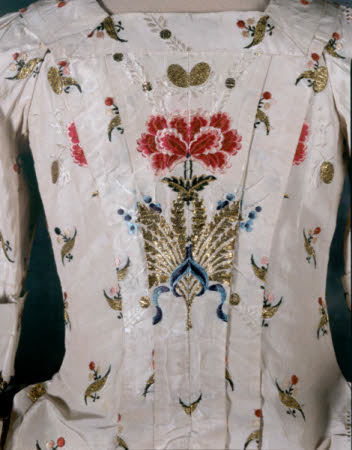Court mantua dress
Category
Costume
Date
c. 1748 - c. 1750
Materials
Ivory silk brocade with silver gilt metal thread and gold braid; linings of linen, pale blue and ivory silk
Measurements
144 x 82 cm
Place of origin
England
Order this imageCollection
Springhill, County Londonderry
NT 603183.1
Caption
The brilliantly preserved silk of this court dress, shimmering with gilt thread in a design of red poppies and golden wheatsheaves, would have been the peak of fashion in the 1740s. The dress was made for Lady Ann Bligh (d.1789) shortly after her marriage to Bernard Ward, 1st Viscount Bangor (1719–81), of Castle Ward in Northern Ireland. The fabric, hand-woven in Spitalfields, London, has a botanical design incorporating white and gold, a feature of formal fashion at this date. Although worn very rarely, the enormous cost of this exquisite dress ensured its survival. The dress was altered in the 19th century and was worn in 1845 to attend a historical ball at Buckingham Palace. However, when worn by Ann Bligh in the 1740s, the skirt would have been stretched out over a wide hoop of 150–180cm. To move gracefully in this type of dress would have required considerable practice and agility. For the Victorian ball, the voluminous skirt was dramatically altered to a more fashionable shape.
Summary
A gown of ivory silk brocaded in coloured silks and metal thread woven in Spitalfields, London, in a fashionable pattern of intertwining poppy and forget-me-not sprigs, corn sheaves and ribbons in a style similar to the designs of leading English pattern maker Anna Maria Garthwaite (1690-1763), c.1745-50. Originally fashioned as a mantua, a type of English court dress worn by women, it would have consisted of a bodice with a train at the back opening to reveal a matching petticoat and stomacher at the front. Remodelled in 1845, the flatter, wider form of the train and petticoat have been replaced by a closely fitting bodice at the back above a bell-shaped form.
Full description
Created for Lady Ann Bligh in the early years of her marriage to Bernard Ward of Castle Ward, this is a very rare example of mid-18th century court dress. It is particularly significant for the extremely high quality and pristine condition of the fabric, hand woven in the Spitalfields area of London: its colours are unfaded and the gilt thread as bright as the moment it came off the loom. The use of white and gold was reserved for the most formal occasions, while the poppies, forget-me-nots and ears of corn scattered across the silk reflect the contemporary British craze for botanical illustration. In 1845, Lady Mary Herbert borrowed the gown from her sister, the Countess of Clanwilliam, to attend Queen Victoria’s 1740s Costume Ball at Buckingham Palace. As reported in exuberant detail in the Illustrated London News, among the 1200 guests ‘every possible variety of colour, texture, and material, and the greatest magnificence of embroidery and jewelled decoration consistent with propriety, were brought to bear on this quaint and antiquated costume’. Partnered by Viscount Sidney, Lady Mary danced in the royal set for the Queen’s third minuet of the evening. The dress was modified considerably for this event, including changing the shape of the bodice to fit the softer, curving lines of mid 19th-century corsetry. Although many of these later alterations have been reversed, the graceful bell shape of the petticoat is likely to be close to its 1845 form. In the 1740s, however, the skirt would have been worn over narrow hoops some 5-6 feet wide, presenting a magnificent, flat expanse of silk brocade. A woman caught within this strikingly exaggerated silhouette would seem stately and remote. Negotiating the bulk and weight of the hooped petticoat was an art which required considerable practice. Fainting from the stress of it all was a well-known hazard of court presentation, particularly as retiring from the sovereign’s presence involved walking backwards. But if Ann Bligh managed to carry it off with élan she must have made a splendid figure, gliding amidst a shimmering haze of golden wheat, glittering in the candlelight.
Provenance
Passed from Lady Ann Bligh to her daughter Theodosia Magill, Countess of Clanwilliam, in whose family it remained. Presented to the National Trust in 1979 by the 6th Earl of Clanwilliam, National Trust Northern Ireland Committee Chairman 1964-78.
References
Ashelford 1996: Jane Ashelford, The Art of Dress: Clothes and Society, 1500-1914 (London: National Trust; 1996), pp.144-147 Browne 1996: Clare Browne (ed.), Silk Designs of the Eighteenth Century from the Victoria and Albert Museum, London (London: Thames and Hudson; 1996)

